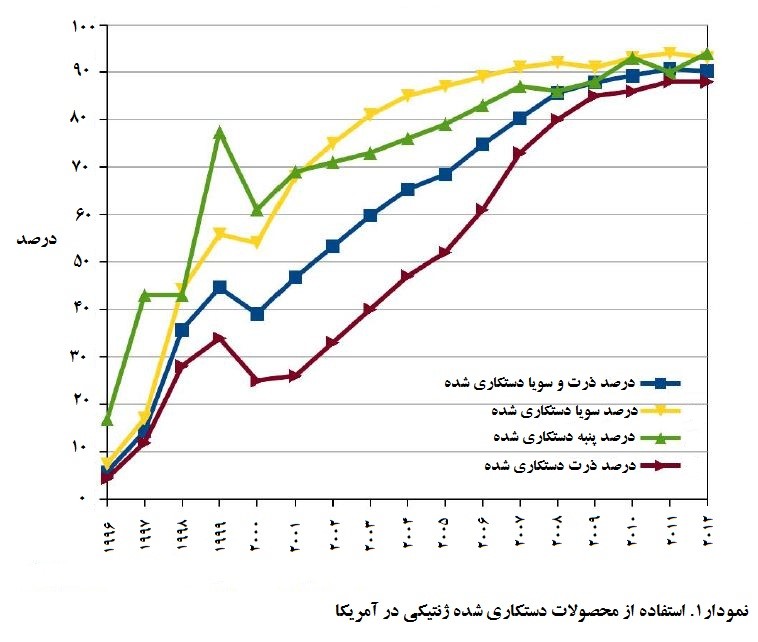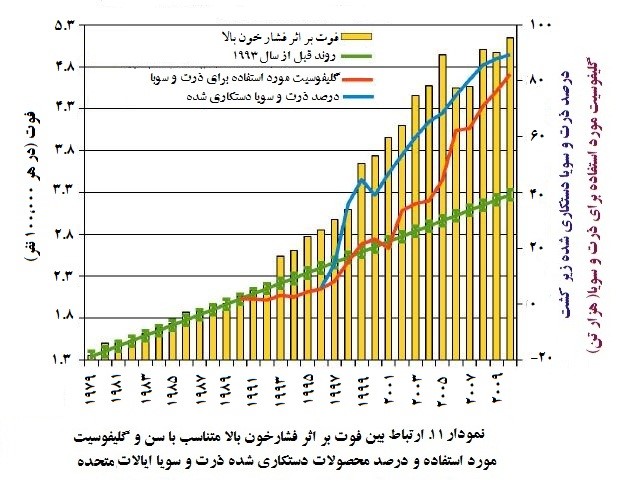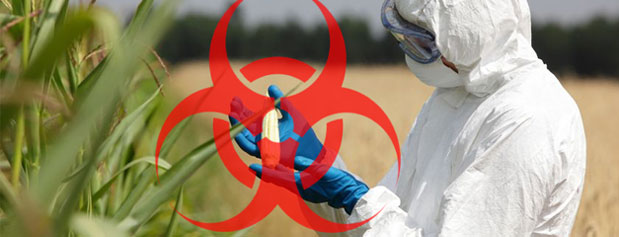سلامت نیوز-*فرناز افشار ابراهیمی:نتایج به دست آمده نشان داده شده سرطان تیروئید و مثانه با ظهور محصولات GE و برنامه های کاربردی گلایفوسیت در ارتباط است. به نظر می رسد سرطان تیروئید زنان را بیشتر تحت تاثیر قرار می دهد در حالی که مردان بیشتر مستعد ابتلا به سرطان کبد و کلیه هستند.
به گزارش سلامت نیوز،در اولین قسمت از مقاله بررسی ارتباط مصرف محصولات تغییر یافته ژنتیکی و تاثیر علفکش گلایفوسیت مورد استفاده در این محصولات با بدتر شدن وضعیت سلامت در ایالات متحده امریکا به مباحث مهندسی ژنتیک،افزایش تصاعدی استفاده از علف کش در سراسر جهان،گلایفوسیت و بیماری ها پرداخته شد.اکنون دومین بخش از این مقاله را در ادامه می خوانید:
مواد و روش ها
پایگاه داده های دولت ایالات متحده برای داده های محصول GE، داده های برنامه گلایفوسیت و اطلاعات بیماری اپیدمیولوژیک جستجو شد. سپس تجزیه و تحلیل همبستگی بر روی این سری زمانی مجموعه داده انجام شد.
اطلاعات محصول
سرویس آمار کشاورزی ملی وزارت کشاورزی ایالات متحده(USDA: NASS) یک پایگاه داده از محصولات زراعی دارد. هر ساله آنها به طور تصادفی مزارع برخی از محصولات را انتخاب و نظرسنجی برای مدیران این زمین ها ارسال می کنند. در میان چیزهای دیگر، آنها می پرسند چه علف کشی استفاده می شود، میزان و تعداد دفعات مصرف و اینکه با انواع GEدر مزرعه کاشته شده یا نه. نظر سنجی ها تنها به ایالاتی که تولید کنندگان عمده یک محصول هستند ارسال می شود، معمولا حدود 90 درصد از وسعت زمین زیر کشت این محصول است. پس از آن آنها تجزیه و تحلیل آماری آماده و گزارش کل وسعت زمین زیر کشت، درصد جریب که GE هستند، درصد جریب سمپاشی شده با هر نوع علف کش و میزان استفاده سالانه در هر جریب را ارائه می دهند.
فایل های داده USDA حاوی اطلاعات انواع GE موجود از 2000-2013 می باشد (USDA:NASS 2013a) ، اما تنها ذرت، پنبه و سویا بررسی می شوند. داده های سال های 1996-1999 از یک گزارش کشاورزی USDA به دست آمد (Fernandez-Cornejo & McBride, 2002) . بررسی85-90٪ از همه ذرت، پنبه و سویا کاشته شده در ایالات متحده را به خود اختصاص داده است. اشتباهات نمونه برداری برای درصد محصولات GE کاشته شده با توجه به تفاوت در سال کشت و نوع محصول 1 تا 2 درصد متفاوت است. (نمودار1)
فایل های داده حاوی اطلاعات کاربرد علف کش سال های 1990-2012 در دسترس است(USDA:NASS 2013b) . اشتباهات نمونه گیری (به عنوان خطاهای استاندارد گزارش شده اند) کوچک هستند در هر دو PATو میزان استفاده هنگامی که PAT بیش از 50٪ است. اشتباهات نمونه گیری 5 تا 10 درصد است اگر PAT بین 10-50٪ باشد و در حالی که اشتباهات نمونه گیری 10 تا 100 درصد است اگر PAT کمتر از 10٪ باشد. ما اطلاعات برنامه های کاربردی علف کش برای ذرت، پنبه و سویا را استخراج کردیم. داده ها برای پنبه شامل این نتایج نمی شد، به جز روغن پنبه دانه در مواد غذایی و کنجاله پنبه دانه در مواد غذایی حیوانی، پنبه یک محصول غذایی در نظر گرفته نمی شود. هر چند تولید کنندگان ادعا می کنند که هیچ ذره یا صفات GE در غذاهای فرآوری شده (مانند روغن) وجود ندارد، گزارش شده است که باقی مانده گلایفوسیت تاppm 0.350 در روغن سویا تصفیه شده شناسایی شده است (GEAC, 2006).





از این داده ها، همراه با کل سطح زیرکشت تحت بررسی در ایالات ، میزان علف کش (در تن) مورد استفاده برای محصولات ذرت و سویا در این کشورها برای هر سال از 1990-2010 محاسبه و در نمودار6 نشان داده شده است. محاسبه: میزان استفاده (پوند / جریب / سال) * PAT / 100 در کل جریب زیر کشت. سهم گلایفوسیت در سویا حدود دو برابر ذرت است. در حالی که ذرت و سویا عمده محصولات غذایی آمریکا (75- 80 میلیون جریب زیر کشت سالانه) هستند، ذرت GE آهسته تر مورد استقبال قرار گرفت (نمودار 1) و گونه ذرت GEقبلی فقط Bt بود. منحنی گلایفوسیت اعمال شده به هر سه محصول تنها نشان می دهد که شکل منحنی بدون تغییر است، بنابراین بعید است با وجود پنبه تغییری در نتایج وجود داشته باشد.

داده های بیماری اپیدمیولوژیک
پایگاه های داده برای داده های اپیدمیولوژیک در مورد بیماری هایی بررسی شدند که ممکن است با استفاده از گلایفوسیت و / یا رشد محصول GE بر اساس اطلاعات داده شده در مقدمه مرتبط باشند. منبع اولیه برای این داده ها مراکز کنترل و پیشگیری از بیماری (CDC) بود. این داده ها براساس مقدار گلایفوسیت اعمال شده برای ذرت و سویا از نمودار 6 و درصد کلی محصولات ذرت و سویا GE از نمودار 1 ترسیم شدند. درصد ذرت و سویا GE کاشته است به این روش به دست می آید: (تعداد تخمینی کل جریب سویا GE + تعداد تخمینی کل جریب ذرت GE) / (کل جریب برآورد شده سویا + کل جریب برآورد شده ذرت) * 100، آن اعداد برآورد شده براساس گزارش وزارت کشاورزی ایالات متحده است که در بالا ذکر شد.
تجزیه و تحلیل آماری
تجزیه و تحلیل آماری در هر یک از مجموعه داده ها انجام شد. تجزیه و تحلیل استاندارد برای مرتبط کردن دو مجموعه از داده ها محاسبه ضریب همبستگی پیرسون است. ضریب همبستگی پیرسون بر اساس فرمول خطی حداقل مربعات است ، که به نوبه خود براساس این فرض است که هر یک از متغیرهای فردی دارای توزیع نرمال است. تمام داده های دولت ایالات متحده، داده محصول و بیماری، از نظرسنجی ها و داده های سرشماری جمع آوری شده است. این داده ها تجزیه و تحلیل و نتایج به طور متوسط همراه با خطا (انحراف معیار از میانگین)، نشان می دهد که توزیع نرمال در روشهای آماری مورد استفاده در نظر گرفته شده است.
ما قطعه های پراکنده تولید شده برای هر مجموعه از داده (بیماری در مقابل برنامه های کاربردی گلایفوسیت و بیماری در مقابل درصد محصولات GE) را برای تعیین اینکه آیا روش همبستگی پیرسون(به عنوان مثال روش خطی leastsquares) مناسب بود یا نه را جمع آوری کردیم. قطعه های پراکنده یک رابطه خطی قوی بین دو مجموعه داده در همه موارد را نشان داد. قطعه باقیمانده ها برای اعلام همگن بودن مورد بررسی قرار گرفت.
بسیاری از داده ها CDC ذخیره و با توجه به طبقه بندی کد بین المللی بیماری(ICD) بازیابی شده اند. این کدها از سال 1998 تا 1999 تغییر کرده و موجب برخی نگرانی ها که می تواند به دلیل گسست در بین نمودار ها بین آن سال ها به دلیل برنامه نویسی نادرست و یا اضافه یا کم شدن دسته بندی ها باشد، شده است. این تنها در نمودار آلزایمر نشان داده شده است . معلوم نیست که آیا پرش در داده در این نمودار واقعی بوده یا به دلیل تغییر کد است.
نتایج و بحث
نمودارها به دسته های بیماری مرتبط گروه بندی می شوند. اگر داده های بیماری قبل از دهه 1990 به صورت خطی افزایش یافته بود، روند خطی در نمودار با رنگ سبز مشخص شده است. خطا در خطوط سبز نمودار خطاهای استاندارد باقی مانده از حداقل مربعات مناسب است. در برخی موارد، خطوط سبز محور برای بهتر نشان دادن همبستگی تنظیم شده اند؛ در غیر این صورت داده ها رسم شده اند. در تمام موارد، محور عمودی سمت چپ شیوع و یا میزان بروز و مرگ در این بیماری است. محور عمودی سمت راست درصد ذرت و سویا GE کاشته شده و مقدار (در 1000 تن) علف کش اعمال شده به محصولات ذرت و سویا است.
ارتباط بین سرطان های کبد، کلیه، مثانه، و تیروئید با کاشت محصولات GE و برنامه های کاربردی علف کش.
اپیدمیولوژی داده برای بروز سرطان از موسسه ملی سرطان ، اپیدمیولوژی و نتایج نهایی (SEER)) پایگاه داده (موسسه ملی سرطان، 2013) گرفته شده است. بر اساس گزارش های منتشر شده در تجزیه کنندگان درون ریز، ما انتظار داشتیم همبستگی برای: سرطان های لنفوم غیر هوچکین(کمی افزایش)، پروستات (نوسان)، بیضه (کمی افزایش)، روده بزرگ (کمی کاهش) و پستان (کمی کاهش) پیدا کنیم، اما نکردیم. کاهش در سرطان پستان می تواند ناشی از کاهش استفاده از درمان جایگزینی هورمون باشد (Chlebowski, 2012) .
ما همبستگی قوی برای سرطان کبد، کلیه، مثانه / ادراری و تیروئید پیدا کردیم. نتایج به دست آمده در نمودارهای 7-10 نشان داده شده است. سرطان تیروئید و مثانه با ظهور محصولات GE و برنامه های کاربردی گلایفوسیت در ارتباط است. به نظر می رسد سرطان تیروئید زنان را بیشتر تحت تاثیر قرار می دهد در حالی که مردان بیشتر مستعد ابتلا به سرطان کبد و کلیه(در نمودار نشان داده نشده است) هستند. ما ارتباط ضعیف بین بروز سرطان لوزالمعده (R = 0.84 با٪ GE محصولات زراعی و R = 0.92 با برنامه های کاربردی علف کش ) و مرگ ناشی از لوسمی میلوئید حاد (R = 0.89 با٪ محصولات GEو R = 0.88 با برنامه های کاربردی علف کش ) پیدا کردیم. هر دو مورد در دهه 80 به اوج خود رسید، پس از آن کاهش یافته و اکنون افزایش است. بروز سرطان لوزالمعده در دهه 80 شروع و دوباره در سال 1996 افزایش یافت و مرگ و میر در لوسمی میلوئید در 1989 اتفاق افتاد.






ارتباط بین چاقی، اختلال متابولیسم لیپوپروتئین و دیابت با کاشت محصولات GE و برنامه های کاربردی علف کش
اطلاعات اپیدمیولوژیک مرگ در اثر چاقی، اختلال در متابولیسم لیپوپروتئین (هیپرلیپیدمی و کلسترول) و بروز و شیوع دیابت همبستگی قوی با استفاده گلایفوسیت و رشد محصول GE نشان داد. اطلاعات مرگ دوباره از فایل های مرگ و میر CDC به دست آمد (CDC, 2013b). داده های شیوع (CDC, 2013c) و بروز (CDC, 2013d) دیابت از مرکز ملی آمار بهداشت CDC به دست آمد. نتایج در نمودار13-16 نشان داده شده است.
با توجه به CDC، حدود یک سوم از افراد مبتلا به دیابت شناخته نشده اند. بنابراین، تحقیقات سازمان بهداشت ملی اهمیت بروز واقعی و شیوع دیابت را بررسی می کند. از آنجا که دیابت و چاقی با مصرف قند در ارتباط است، ما سرانه تحویل شیرین کننده برای مصرف در ایالات متحده (USDA, 2013) را در نمودار 17 به تصویر کشیدیم. بیشترین میزان قند مصرف شده از ذرت، چغندر قند و نیشکر است. در سال 2011، 88٪ از ذرت (USDA:NASS, 2013a) و 90 درصد از چغندر قند (ISAAA, 2011) کاشته شده در آمریکا GE بود. گلایفوسیت به صورت معمول در زمان رسیدن و خشک کردن محصول مورد استفاده قرار می گرفت (Orgeron, 2012).
چربی خون با التهاب لوزالمعده (پانکراتیت)، درد شکم، بزرگ شدن کبد و طحال و ضایعات پوستی زرد کوچک به نام xanthomasشناخته می شود(Raphael, 1993; Berglund, 2012) . بیماری های مرتبط با چربی خون ثانویه عبارتند از چاقی، دیابت (نوع I و II) چربی خون، کم کاری تیروئید، سندرم کوشینگ، بیماری مزمن کلیوی، سندرم نفروتیک، و اختلال کلستاز است که عامل خطر عمده برای تصلب شرایین و بیماری های قلبی عروقی می باشد.
طبق گفته سامسل و سنف( Samsel & Seneff ، 2013a ) ، گلایفوسیت آنزیم CYP که به شدت در تولید اسیدهای صفراوی درگیر هستند را مختل می کند. معمولا، کبد بسیاری از کلسترول را به صورت سولفات کلسترول به اسیدهای صفراوی تبدیل می کند. این اجازه می دهد تا دستگاه گوارش چربی ها را هضم کند که پس از آن شیلومیکرون با سولفات کلسترول بسته بندی شده به پوسته بیرونی خود را برای ارائه کلسترول به تمام بافت های بدن تبدیل شود. زمانی که کبد نتواند اسیدهای صفراوی تولید کند، مجبور به تبدیل به کلسترول LDL شده و با افزایش LDL، چربی خون ایجاد می شود.
علاوه بر این، اختلال در متابولیسم لیپوپروتئین با آلزایمر (AD) و بیماری پارکینسون مرتبط است (Merlo, 2010).. با توجه به مرلو، "شواهد اخیر ارتباط محکمی بین اختلالات متابولیک و AD نشان می دهد. در دهه گذشته توجه زیادی به طور خاص به ارتباط بین اختلال در عملکرد متابولیسم چربی و ADجلب شده است. ما در اینجا در مورد جنبه های تنظیم چربی، از جمله تغییرات در سطح کلسترول، عملکرد آپولیپوپروتئینها و لپتین، و چگونگی ارتباط آن ها با پاتوژن های AD بحث می کنیم. با وجود شواهد گسترده موجود، بسیاری از جنبه ها هنوز هم نیاز به شفاف سازی دارند. با این وجود، مسیر جنبه های تنظیم چربی را به طور مستقیم به AD متصل می کند (p. 537) .




ادامه دارد...
*کارشناس ارشد میکروبیولوژی
منابع:
References
Anderson, M.D., 2012. Autism Prevention Care and Management. Traverse City, Michigan: Allegra
Printing.
Antoniou, M., Habib, M.E.M., Howard, C.V., Jennings, R.C., Leifert, C., Nodari, R.O., Robinson, C.J.
and Fagan. J., 2012. Teratogenic Effects of Glyphosate-Based Herbicides: Divergence of
Regulatory Decisions from Scientific Evidence. Journal of Environmental and Analytical
Toxicology, S: 4.
Arregui, M.C., Lenardón, A., Sanchez, D., Maitre, M.I. and Enrique, S., 2004. Monitoring glyphosate
residues in transgenic glyphosate-resistant soybean. Pesticide Management Science, 60(2): 163-
166.
Swanson, Leu, Abrahamson & Wallet Journal of Organic Systems, 9(2), 2014
34
Ashwood P., Murch S.H., Anthony A., Pellicer A.A., Torrente F., Thomson M.A., Walker-Smith, J.A.
and Wakefield A.J., 2003. Intestinal Lymphocyte Populations in Children with Regressive Autism:
Evidence for Extensive Mucosal Immunopathology. Journal of Clinical Immunology, 23(6): 504-
517.
Autoimmunity Research Foundation., 2012. Incidence and Prevalence of Chronic Disease.
Autoimmunity Research Foundation. http://mpkb.org/home/pathogenesis/epidemiology (Viewed: 9
February 2013)
Benbrook, C.B., 2012. Impacts of genetically engineered crops on pesticide use in the U.S. -- the first
sixteen years. Environmental Sciences Europe, 24(24): 2190-4715.
http://www.enveurope.com/content/24/1/24 (Viewed: 9 February, 2013)
Berglund, L., Brunzell, J.D., Goldberg, A.C., Goldberg, I.J., Sacks, F., Murad, M.H. and Stalenhoef,
A.F.H., 2012. Evaluation and treatment of hypertriglyceridemia: an endocrine society clinical
practice guideline. Journal of Clinical Endocrinology and Metabolism, 97 (9): 2969–89.
Bergman, A., Heindel, J.J., Jobling, S., Kidd, K.A. and R. Zoeller, T. (eds.), 2013. State of the science
of endocrine disrupting chemicals 2012, United Nations Environment Programme and the World
Health Organization, ISBN: 978-92-807-3274-0 (UNEP) and 978 92 4 150503 1 (WHO) (NLM
classification: WK 102)
Bezruchka, S., 2012. The Hurrider I Go the Behinder I Get: The Deteriorating International Ranking of
U.S. Health Status. Annual Review of Public Health, 33: 157-173.
Bohn, T., Cuhra, M., Travail, T., Sanden, M., Fagan, J. and Primicerio, R., 2014. Compositional
differences in soybeans on the market: glyphosate accumulates in Roundup Ready GM soybeans.
Food Chemistry. 153: 207-15.
Carman, J. A., Vlieger, H.R., Ver Steeg, L.J., Sheller, V.E., Robinson, G.W., Clinch-Jones C.A.,
Haynes, J.I., John, W. and Edwards, J.W., 2013. A long-term toxicology study on pigs fed a
combined genetically modified (GM) soy and GM maize diet, Journal of Organic Systems, 8(1):
38-54.
Cattani, D., de Liz Oliveira Cavalli, V.L., Heinz Rig, C.E., Dominguez, J.T., Dal-Cim, T., Tosca, C.I.,
Mena Barreto Silva, F.R. and Zamoner, A,. 2014. Mechanisms underlying the neurotoxicity
induced by glyphosate-based herbicide in immature rat hippocampus: Involvement of glutamate
excitotoxicity. Toxicology. 2014 Mar 15;320C:34-4.
CDC, 2013a. Rising Health Care Costs are Unsustainable, Centers for Disease Control and
Prevention. http://www.cdc.gov/workplacehealthpromotion/businesscase/reasons/rising.html
(Viewed: 17 December 2013)
CDC, 2013b. Death data, Centers for Disease Control and Prevention, National Center for Health
Statistics. Compressed Mortality Files on CDC WONDER Online Database. 1999-2010 Data are
compiled from Compressed Mortality File 1999-2010 Series 20 No. 2P, released Jan. 2013. 1989-
1998 Data are compiled from Compressed Mortality File CMF 1989-1998, Series 20, No. 2E,
2003. Available at: http://wonder.cdc.gov/mortSQL.html (Last viewed: 19 November 2013)
CDC, 2013c. Diabetes prevalence data. Centers for Disease Control and Prevention, National Center
for Health Statistics, Division of Health Interview Statistics, data from the National Health Interview
Survey. Statistical analysis by the Centers for Disease Control and Prevention, National Center for
Chronic Disease Prevention and Health Promotion, Division of Diabetes Translation.
http://www.cdc.gov/diabetes/statistics/prev/national/figage.htm (Last viewed: 19 November 2013)
CDC, 2013d. Diabetes incidence data. Centers for Disease Control and Prevention, National Center
for Health Statistics, Division of Health Interview Statistics, data from the National Health Interview
Survey. Data computed by personnel in the Division of Diabetes Translation, National Center for
Chronic Disease Prevention and Health Promotion.
http://www.cdc.gov/diabetes/statistics/incidence/fig2.htm (Last viewed: 19 November 2013)
CDC, 2013e. Hospital discharge data. Centers for Disease Control and Prevention. Available at:
http://www.cdc.gov/nchs/nhds/nhds_publications.htm (Last viewed: 10 December 2013)
Chang, F.C., Simcik, M.F. and Capel, P.D., 2011. Occurrence and fate of the herbicide glyphosate
and its degradate aminomethylphosphonic acid in the atmosphere. Environmental Toxicology and
Chemistry, 30(3): 548-55.
Chlebowski, R.T. and Anderson, G.L., 2012. Changing Concepts: Menopausal Hormone Therapy and
Breast Cancer. Journal of the National Cancer Institute, 104 (7): 517-527.
Coupe, R.H., Kalkhoff, S.J., Capelc, P.D., and Gregoired, C., 2012. Fate and transport of glyphosate
and aminomethylphosphonic acid in surface waters of agricultural basins. Pest Management
Science, 68(1): 16-30.
de Cock, M., Maas, Y.G. and van de Bor M., 2012. Does perinatal exposure to endocrine disruptors
induce autism spectrum and attention deficit hyperactivity disorders? Acta Paediatric, 101(8): 811-
819.
de Liz Oliveira Cavalli, V.L., Cattani, D., Heinz Rieg, C.E., Pierozan. P., Zanatta. L., Benedetti
Parisotto, E., Wilhelm Filho, D., Mena Barreto Silva, F.R. and Pessoa-Pureur R,Zamoner, A,.
Swanson, Leu, Abrahamson & Wallet Journal of Organic Systems, 9(2), 2014
35
2013. Roundup disrupts male reproductive functions by triggering calcium-mediated cell death in
rat testis and Sertoli cells. Free Radical Biology & Medicine. 65:335-46.
Dean, A. & Armstrong, J., 2009. Genetically Modified Foods, American Academy of Environmental
Medicine Position Paper, online. http://aaemonline.org/gmopost.html
El-Shenawy, N.S., 2009. Oxidative stress responses of rats exposed to Roundup and its active
ingredient glyphosate. Environmental Toxicology and Pharmacology. 28(3):379-85.
EPA, 2013. Electronic Code of Federal Regulations, Title 40: Protection of Environment. PART 180—
Tolerances and Exemptions for Pesticide Chemical Residues in Food. Subpart C—Specific
Tolerances. Environmental Protection Agency, Washington, DC.
Ewen, S.W. and Pusztai, A., 1999. Effect of diets containing genetically modified potatoes expressing
Galanthus nivalis lectin on rat small intestine. Lancet, 354(9187): 1353-1354.
FDA,1992. Statement of Policy - Foods Derived from New Plant Varieties. FDA Federal Register
Volume 57. Food and Drug Administration, Silver Spring.
Fernandez-Cornejo, J. and McBride, W., 2002. Adoption of Bioengineered Crops. USDA Economic
Research Service Agricultural Economic Report No. (AER-810) USDA Agricultural Economic
Report No. (AER-810) 67 pp, May 2002
Furuta, A., Salam, K.A., Akimitsu, N., Tanaka, J., Tani, H., Yamashita, A., Moriishi, K., Nakakoshi, M.,
Tsubuki, M., Sekiguchi, Y., Tsuneda, S. and Noda, N., 2013. Cholesterol sulfate as a potential
inhibitor of hepatitis C virus NS3 helicase. Journal of Enzyme Inhibition and Medicinal Chemistry,
29(2): 223-229.
Gallup, R., 2002. The Autism Epidemic in the USA-Our Bitter Harvest and National Shame.
Vaccination News. www.vaccinationnews.com/Scandals/feb_15_02/GallupPressRelease.htm
(Last viewed: 21 November 2013)
Gasnier, C., Dumont, C., Benachour, N., Clair, E., Chagnon, M.C. and Séralini, G.E., 2009.
Glyphosate-based herbicides are toxic and endocrine disruptors in human cell lines. Toxicology,
262(3): 184-191.
GEAC, 2006. Decisions taken in the 71st Meeting of the Genetic Engineering Approval Committee
held on 11.10.2006. Genetic Engineering Approval Committee, Ministry of Environment and
Forests, Government of India, Sect. 1.1.4.
Ghosh, A., 2010. Endocrine, metabolic, nutritional, and toxic disorders leading to dementia. Annals of
Indian Academy of Neurology, (Suppl 2): S63-8.
Guengerich, F.P., 2008. Cytochrome P450 and chemical toxicology. Chem. Res. Toxicol. 21(1): 70-
83.
Hill, A., 1965. The environment and disease: Association or causation. Proceedings of the Royal
Society of Medicine, 58 (5): 295-300.
Ho, M.W., Ryan, A. and Cummins, J., 2009. New evidence links CaMV 35S promoter to HIV
transcription. Microbial Ecology in Health and Disease, 21: 172–174.
Ho, M., 2013. The New Genetics and Natural versus Artificial Genetic Modification. Entropy, 15(11),
4748-4781. http://www.mdpi.com/1099-4300/15/11/4748 (Viewed: 14 October, 2013)
International Service for the Acquisition of Agri-biotech Applications, 2011. Global Status of
Commercialized Biotech/GM Crops: 2011. ISAAA Brief 43-2011. International Service for the
Acquisition of Agri-biotech Applications, Ithaca.
Jayasumana, C., Gunatilake, S. and Senanayake, P., 2014. Glyphosate, Hard Water and Nephrotoxic
Metals: Are They the Culprits Behind the Epidemic of Chronic Kidney Disease of Unknown
Etiology in Sri Lanka? International Journal of Environmental Research and Public Health, 11,
2125-2147;
Joyner-Grantham, J., Simmons, D.R., Moore, M.A. and Ferrario, C.M., 2010. The impact of changing
ICD code on hypertension-related mortality in the southeastern United States from 1994-2005.
Journal of Clinical Hypertension, 12(3): 213-22.
Kang, D., Park, J.G., Ilhan, Z.E., Wallstrom, G., LaBaer, J., Adams, J.B. and Krajmalnik-Brown, R.,
2013. Reduced incidence of Prevotella and other fermenters in intestinal microflora of autistic
children. PLoS ONE, 8(7): e68322.
Kavlock, R.J., Daston, G.P., DeRosa, C., Fenner-Crisp, P., Gray, L.E., Kaattari, S., Lucier, G., Luster,
M., Mac, M.J., Maczka, C., Miller, R., Moore, J. Rolland, R., Scott, G., Sheehan, D.M. Sinks, T.
and Tilson, H.A., 1996. Research needs for the risk assessment of health and environmental
effects of endocrine disruptors: a report of the U.S. EPA-sponsored workshop. Environmental
Health Perspectives, 104(Suppl 4): 715-740.
Kruger, M., Shehata, A.A., Schrödl, W. And Rodloff, A., 2013a. Glyphosate suppresses the
antagonistic effect of Enterococcus spp. On Clostridium botulinum. Anaerobe, 20: 74-78.
Kruger, M., Schrödl, W., Neuhaus, J. and Shehata, A.A., 2013b. Field Investigations of glyphosate in
urine of danish dairy cows. Journal of Environmental and Analytical Toxicology, 3(5): 186-192.
Swanson, Leu, Abrahamson & Wallet Journal of Organic Systems, 9(2), 2014
36
Kruger, M., Schledorn, P., Schrödl, W., Hoppe, H.W., Lutz, W. and Shehata, A.A., 2014. Detection of
glyphosate residues in animals and humans. Journal of Environmental and Analytical Toxicology,
4(2): 210-15.
Lushchak, O.V., Kubrak, O.I., Storey, J.M., Storey, K.B. and Lushchak, V.I., 2009. Low toxic herbicide
Roundup induces mild oxidative stress in goldfish tissues. Chemosphere. 76(7): 932-7.
MacSweeney, D., Timms, P. and Johnson A., 1978. Preliminary communication thyro-endocrine
pathology, obstetric morbidity and schizophrenia: survey of a hundred families with a
schizophrenic proband. Psychological Medicine, 8(1): 151-155.
Majewski, M.S., Coupe, R.H., Foreman, W.T. and Capel, P.D., 2014. Pesticides in Mississippi air and
rain: a comparison between 1995 and 2007. Environmental Toxicology and Chemistry, 33(6):
1283-1293.
Marc, J., Mulner-Lorillon, O. and Bellé, R., 2004. Glyphosate-based pesticides affect cell cycle
regulation, Biology of the Cell, 96(3): 245-249.
Mercurio P, Flores F, Mueller JF, Carter S, Negri AP. 2014. Glyphosate persistence in seawater.
Marine Pollution Bulletin, 85(2): 385-390.
Merlo, S., Spampinato, S., Canonico, P.L., Copani, A. and Sortino, M.A., 2010. Alzheimer s disease:
brain expression of a metabolic disorder? Trends in Endocrinology and Metabolism, 21(9): 537-
544.
Monsanto International sàrl and Monsanto Europe sa, 2010. The Agronomic Benefits of Glyphosate in
Europe-Benefits of glyphosate per market use—REVIEW
www.monsanto.com/products/Documents/glyphosate-backgroundmaterials/
Agronomic%20benefits%20of%20glyphosate%20in%20Europe.pdf (Viewed: 3
September, 2013)
National Cancer Institute, 2013. Cancer data: National Cancer Institute-Surveillance Epidemiology and
End Results (SEER) SEER 9 areas (San Francisco, Connecticut, Detroit, Hawaii, Iowa, New
Mexico, Seattle, Utah, and Atlanta). Rates are per 100,000 and are age-adjusted to the 2000 US
Std Population (19 age groups - Census P25-1130).
http://seer.cancer.gov/csr/1975_2009_pops09/browse_csr.php?section=14andpage=sect_14_tabl
e.05.html (Last viewed: 19 November 2013)
Orgeron, A.J., 2012. Sugarcane growth, sucrose content, and yield response to the ripeners
glyphosate and trinexapacethyl. PhD Dissertation, School of Plant, Environmental, and Soil
Sciences, Louisiana State University.
Orson, J.H. and Davies, D.K.H., 2007. Pre-harvest glyphosate for weed control and as a harvest aid in
cereals. Research Review No. 65. HGCA.
Paganelli, A., Gnazzo ,V., Acosta, H., López, S.L. and Carrasco, A.E., 2010. Glyphosate-based
Herbicides Produce Teratogenic Effects on Vertebrates by Impairing Retinoic Acid Signaling.
Chemical Research in Toxicology, 23(10): 1586–1595.
Pulse Growers Association, Canada, 2012. 2012 Harvest management tools and regulatory
requirements for pulse crops. www.manitobapulse.ca/wp-content/uploads/2012-Harvest-
Management-Tools-and-Regulatory-Requirements-for-Pulse-Crops.pdf
Pritchard, C., Meyers, A., and Baldwin, D., 2013. Changing patterns of neurological mortality in the 10
major developed countries.-- 1979-2010. Public Health, 127(4): 357-368.
Raphael, S.J., Macaulay, J.D., Miller, C., Thomas, J. and Asa, S.L., 1993. Pancreatic xanthomatous
neuropathy associated with hyperlipidemia: a cause of abdominal pain mimicking chronic
pancreatitis. Human Pathology, 24(9): 1023-1025.
Reuben, S. H. (ed.), 2010. Reducing environmental cancer risk, what we can do now. US President s
Cancer Panel 2008–2009 Annual Report, April 2010. US Department of Health and Human
Services, National Institutes of Health, National Cancer Institute.
Rosenbloom, A.L., Joe, J.R., Young, R.S. and Winter, W.E., 1999. Emerging epidemic of type 2
diabetes in youth. Diabetes Care, 22(2): 345-354.
Samsel, A. and Seneff, S., 2013a. Glyphosate s suppression of cytochrome P450 enzymes and amino
acid biosynthesis by the gut microbiome: pathways to modern diseases. Entropy, 15(4): 1416-
1463.
Samsel, A. and Seneff, S., 2013b. Glyphosate, pathways to modern diseases II: Celiac sprue and
gluten intolerance. Interdisciplinary Toxicology, 6(4): 159-184.
Scribner, E.A., Battaglin, W.A., Gilliom, R.J. And Meyer, M.T., 2007 Concentrations of glyphosate, its
degradation product, aminomethylphophonic acid, and glufosinate in ground- and surface-water,
rainfall, and soil samples collected in the United States, 2001-06S. Geological Survey Scientific
Investigations Report 2007-5122.
Schulkin, J., 2007. Autism and the amygdala: An endocrine hypothesis. Brain and Cognition, 65(1):
87-99.
Swanson, Leu, Abrahamson & Wallet Journal of Organic Systems, 9(2), 2014
37
Seralini, G.Eric.,Clair, E., Mesnage, R., Gress, S., Defarge, N., Malatesta, M., Hennequin, D. and
Spiroux de Vendômois, J., 2014, Republished study: long-term toxicity of a Roundup herbicide
and a Roundup-tolerant genetically modified maize. Environmental Sciences Europe, 2014: 14.
Seralini, G.E., Mesnage, R., Clair, E., Gress, S., de Vendomois, J. and Cellier, D., 2011. Genetically
modified crops safety assessments: present limits and possible improvements. Environmental
Sciences Europe, 23: 10.
Shehata, A.A., Schrodl, W., Aldin, A.A., Hafez, H.M. and Kruger, M., 2012. The effect of glyphosate on
potential pathogens and beneficial members of poultry microbiota in vitro. Current Microbiology,
66(4):350-8.
Snyder, T.D. and Dillow, S.A., 2012. Digest of Education Statistics 2011. U.S. Dept. of Education,
National Center for Education Statistics, NCES 2012-001 p. 85.
http://nces.ed.gov/pubs2012/2012001.pdf (Last viewed: 21 November 2013) Note: This document
says the data are for children 3-21 served under IDEA, however we obtained the original data files
from data.gov and the data are for children 6-21, as stated.
Soto, A.M. and Sonnenschein, C., 2010. Environmental causes of cancer: endocrine disruptors as
carcinogens, Nature Reviews Endocrinology. 6: 363-370.
Thongprakaisang, S., Thiantanawat, A., Rangkadilok, N., Suriyo, T. and Satayavivad, J., 2013.
Glyphosate induces human breast cancer cells growth via estrogen receptors, Food and Chemical
Toxicology, 59: 129-136.
UA, 2014. The Correlation Coefficient. University of Amsterdam, Amsterdam.
http://www.fon.hum.uva.nl/Service/Statistics/Correlation_coefficient.html (Last viewed: 20 March
2014)
University of Washington Institute for Health and Metrics Evaluation, 2012. Years of Life Lost
Premature Mortality Chart. http://www.healthmetricsandevaluation.org/gbd/visualizations/gbd-
2010-change-leading-causes-and-risks-between-1990-and-2010?metric=YLL (Last viewed: 10
December 2013)
USDA:NASS, 2013a. Acreage planted and/or harvested. USDA Economics, Statistics and Market
Information System. Albert R. Mann Library. Cornell University.
http://usda.mannlib.cornell.edu/MannUsda/viewDocumentInfo.do?documentID=1000 (Last
viewed: 16 November 2013)
USDA:NASS, 2013b. Agricultural Chemical Usage - Field Crops and Potatoes. USDA Economics,
Statistics and Market Information System. Albert R. Mann Library. Cornell University.
http://usda.mannlib.cornell.edu/MannUsda/viewDocumentInfo.do?documentID=1560 (Last
viewed: 16 November 2013)
USDA:NASS, 2013c. Quick Stats. http://quickstats.nass.usda.gov/ (Last viewed: 16 November 2013)
USDA Economic Research Service, 2013. Sugar and Sweeteners Yearbook Tables: Table 50.
http://www.ers.usda.gov/data-products/sugar-and-sweeteners-yearbook-tables.aspx#25512 (Last
viewed: 24 December 2013)
US Geological Survey pesticide use maps, 2013.
http://water.usgs.gov/nawqa/pnsp/usage/maps/show_map.php?year=2009andmap=GLYPHOSAT
Eandhilo=L (Viewed: 14 November, 2013)
Van Cleave, J., Gortmaker, S.L. and Perrin, J.M., 2010. Dynamics of obesity and chronic health
conditions among children and youth. Journal of the American Medical Society, 303(7): 623-630.
Vandenberg, L.N., Colburn, T., Hayes, T.B., Heindel, J.J., Jacobs, D.R. Jr., Lee, D., Shioda, T., Soto,
A.M., vom Sal, F.S., Welshons, W.V., Zeller, R.T. and Myers, J.P., 2012. Hormones and
endocrine-disrupting chemicals: low-dose effects and nonmonotonic dose responses. Endocrine
Reviews, 33(3): 378-455.
Weintraub, K., 2011. The prevalence puzzle: Autism counts. Nature, 479: 22-24.
قسمت اول این مقاله را اینجا بخوانید



















نظر شما